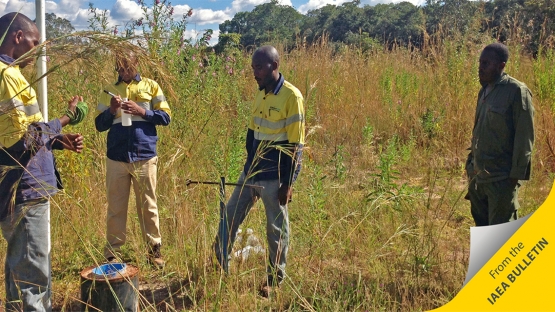Tanzania is at an advanced stage of uranium exploration and plans to commence mining operations at its first approved mining site as soon as economic conditions become favourable and the price of uranium rises, local experts have said. The IAEA has supported the country in the introduction of its uranium mining programme, including through a 2013 advisory mission to get the project off the ground.
Tanzania’s progress will be reviewed at the IAEA’s International Symposium on Uranium Raw Material for the Nuclear Fuel Cycle: Exploration, Mining, Production, Supply and Demand, Economics and Environmental Issues (URAM-2018), which opens on 25 June at the Agency’s headquarters in Vienna.
“Five years on, a lot of progress has taken place,” said Dennis A. Mwalongo, Head of the Department of Ionizing Radiation at the Tanzania Atomic Energy Commission (TAEC). “The government has worked actively to implement the IAEA Uranium Production Site Appraisal Team (UPSAT) recommendations, which include developing appropriate legal and regulatory measures that comply with international requirements.”
The government has completed the first construction phase of the TAEC laboratory complex, which will provide radioanalytical and calibration services to support regulatory oversight of uranium mining in the country and the wider region, he added.
Introducing uranium mining requires long-term planning, which includes surveys of the selected exploration sites, soil assessments, building public awareness and capacity building, he said. “To achieve this, the IAEA UPSAT mission set the platform by providing a comprehensive assessment on uranium mining possibilities in Tanzania.”
The Mkuju River site, the most advanced uranium project in Tanzania, has measured and indicated resources of 36 000 tonnes of uranium and inferred resources of 10 000 tonnes. The site is to be operated by Uranium One, a Russian uranium mining company that plans to produce 1400 tonnes of uranium annually, Mwalongo said. “Uranium mining will contribute to successful and sustainable socioeconomic development for Tanzania. Another important goal is to develop the Dar es Salaam seaport for uranium transport
and export.”
To meet its growing energy demand, Tanzania is planning to introduce nuclear power on the basis of the 2003 Atomic Energy Act, which authorizes the use of uranium to produce electricity. This law has stringent provisions for the safe use of uranium. The decision makes Tanzania the first country in East and Central Africa ready to introduce nuclear power to generate electricity.
Introducing uranium mining requires long-term planning, which includes surveys of the selected exploration sites, soil assessments, building public awareness and capacity building.






